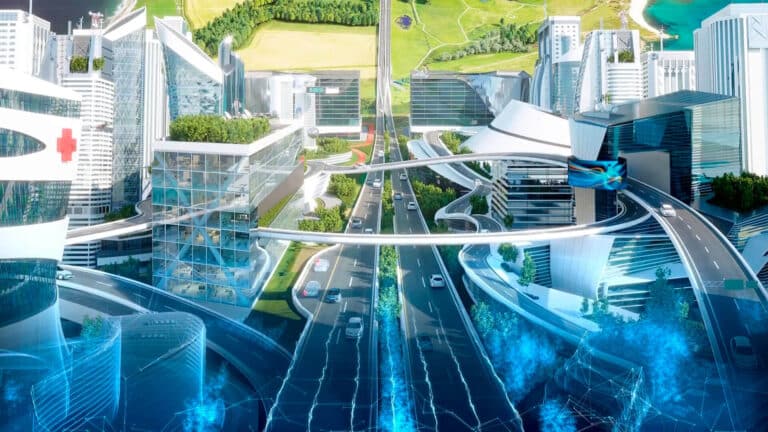What kind of metaverse platforms are available and what are their user numbers? Why are companies and brands buying virtual land and properties? How does the metaverse function from the perspective of a user? Stereoscape’s Karoliina Leisti and Loihde Factor’s Virpi Vaittinen report on their excursion to the world of the metaverse.
What platforms are available in the metaverse?
The metaverse encompasses several platforms and operators, which for their part develop and shape their own version of social interaction in the spatial dimension of the Internet. Today, in addition to Meta, the most talked about platforms in the metaverse are Sandbox, Decentraland, Roblox and Fortnite.
Sandbox
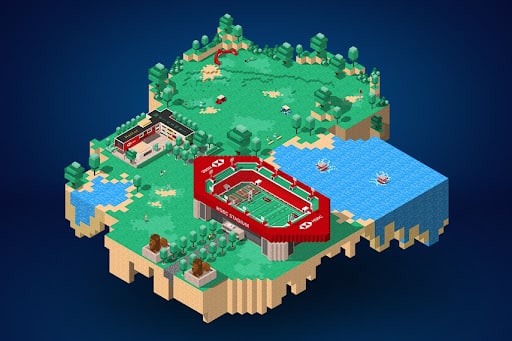
Sandbox is a gaming metaverse that allows users to buy virtual land, build virtual properties and sell the content and experiences they have created. As its currency, it uses non-fungible tokens (NFT), units of data stored on a blockchain, that can be used as proof of ownership of pictures or videos, for example. Unlike cryptocurrencies, NFTs are non-interchangeable. In addition, Sandbox uses its own currency, $SAND. The plan is to arrange virtual gigs in Sandbox and to create a system that enables users to vote on ways to develop the community. A platform for mobile users is also underway, and it is slated for completion by the end of 2022.
During 2021, the number of Sandbox users grew rapidly, reaching half a million wallets. Each month, the service is used by 30,000 active users, about half of whom spend more than an hour a day in the metaverse. Even though Sandbox’s user numbers are still relatively modest, what makes it interesting is that more than a hundred celebrities, musicians, and artists, such as the world-famous rap artist Snoop Dogg, have used Sandbox either to buy virtual land, create content or to build other business operations. Other operators have also found Sandbox: PriceWaterHouseCoopers and HSBC have purchased land and built properties on the platform and South China Morning Post has created virtual environments that bring Hong Kong’s history to life as interactive and immersive experiences. Sandbox is also planning the metaverse’s first hotel.
Decentraland
Decentraland toimii paljolti samaan tapaan kuin Sandbox. Käyttäjät voivat ostaa alustalta maata To a great extent, Decentraland operates similarly to Sandbox. Users can buy land using the MANA cryptocurrency, which utilizes the Ethereum blockchain. In December 2021, Decentraland reported 18,000 daily visitors, with the total number of users reaching 300,000. At the beginning of 2022, Sotheby’s arranged a virtual auction on the platform and global brands from Adidas to Samsung appeared in the service.
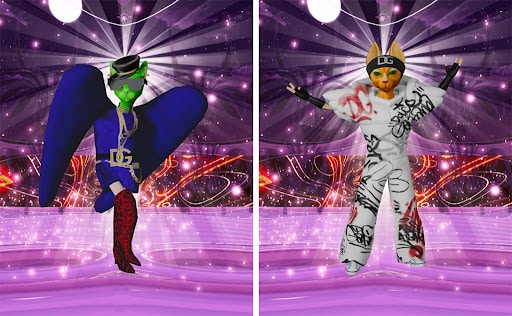
Maaliskuussa 2022 Decentralandissä järjestettiin metaversumin ensimmäiset muotiviikot, joihin In March 2022, Decentraland hosted the metaverse’s first fashion week, with brands such as Tommy Hilfiger, Estee Lauder and Dolce & Gabbana introducing their creations. The hype surrounding the event also reached global media from the Vogue magazine to The Sun tabloid. However, the platform’s user experience still has room for improvement: users who do not have a graphics card for gaming report lag issues and frustration.
Roblox
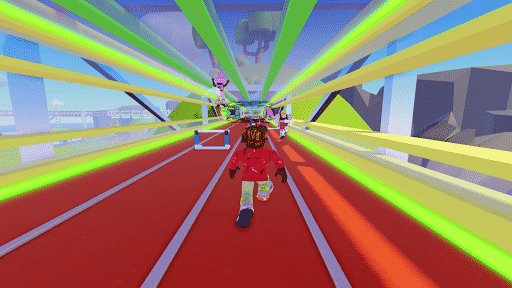
Popular particularly among under-18s, the Roblox platform is a communal market and meeting place where millions of users create immersive content. Users create an avatar for themselves, which they can use to move from one virtual experience and world to another. The platform allows users to participate in millions of different virtual experiences, from adopting a pet to scuba diving.
With Roblox’s tools, anyone can create new 3D games, even without coding skills, and sell them to other users. Sales within the platform are carried out using the virtual Robux currency, which can be bought with “real” money. Robux currency earned in the game can later be exchanged for physical currency.
The global pandemic propelled Roblox to rapid growth in 2020-2021. In terms of user numbers, Roblox is even bigger than the Minecraft game: at the end of 2021, Roblox had an estimated 115 million users globally (compared with. about 100 million Minecraft users), and about 50 million users per day. Brands such as Nike, Ralph Lauren and Vans are building their presence in Roblox.
Fortnite
Launched in 2017, the Fortnite survival game has more than 350 million users, more than 15 million of whom may play the game at the same time. Particularly during the pandemic, the game’s virtual world was for many a meeting place where they could socialize with others, chat, and enjoy themselves. The game’s popularity stems from the game being free and easy to join: it can be played with a PC, mobile device or a game console.
The platform has also hosted concerts by global megastars, including Ariana Grande, and other events, such as movie viewings. The visionary luxury brand Balenciaga collaborates with Roblox by selling accessories to players. In 2022, Fortnite collaborated with the Coachella music festival: players could listen to the performances via a virtual radio channel and buy virtual accessories and other products launched during the festival.
The metaverse’s real estate boom
Real estate trade is heating up in the metaverse. While Sandbox sells the highest number of plots, individual plots in Decentraland fetch the highest prices. Companies, brands, and celebrities are willing to spend millions of dollars in an effort to win bids for the most sought-after plots, which may sell for anything from hundreds of thousands to millions of dollars: in late 2021, Decentraland sold a plot in the virtual Fashion Street district for a whopping 2.4 million dollars.
Virtual architecture
Virtual neighborhoods and centers are cropping up on the metaverse platforms at ever-increasing rates, just like in the real world. Virtual locations have certain advantages over their real-world counterparts: they are accessible from anywhere in the world and in their design, imagination is the only limit. Unlike in the physical world, in the virtual world architectural experiments are not restricted by the laws of gravity, town plans, or safety regulations. On the other hand, new skills are required from architects working in the metaverse: they need to have an understanding of customer experience, gaming, and 3D design.
A virtual world enables interaction, learning, and innovation
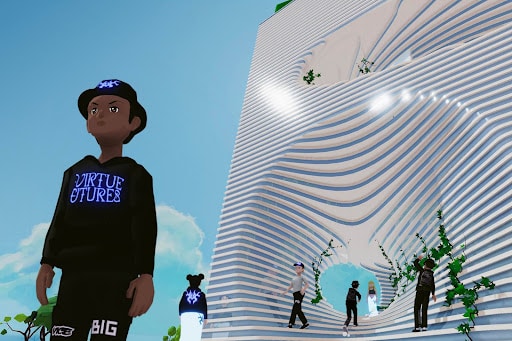
The possibilities brought on by virtual encounters can be utilized not only during leisure but also for work purposes. For example, Vice Media has a virtual office which specializes in innovation activities and where the media company’s global innovation team convenes to realize virtual projects. In the virtual environment, Vice’s employees can experiment, play and learn, and apply their knowledge to their brand collaboration. Viceverse was built on the Decentraland platform and the virtual office building was designed by the Danish architectural company BIG.
How to integrate physical and digital services into a seamless entity?
Navigating the metaverse is not based on linearity, gravity or a geographical location; instead its operating principle is borrowed from the gaming world. Users can move between dimensions and worlds, and they can interact with other people via several channels simultaneously: they can talk, chat, interact via a video connection, and use avatars and filters. Imagination, stories, and emotions play an important role. How do brands and companies integrate their physical and digital dimensions in a way that provides users with a seamless experience and creates a meta identity that supports the brand identity as a whole?
Younger generations are building metaverse platforms of the future
We are facing a digital revolution: as technologies and user habits evolve, the physical and digital experience fuse more seamlessly and digital advances enable social interaction in three-dimensional virtual spaces. These changes concern working life and leisure, retail and consumption in equal measures.
It is clear that navigating the metaverse comes naturally to the younger generations and people used to the gaming world. Others may have to leave their comfort zone when they enter the virtual experience. The designers of the metaverse must know how the gaming world works. A smooth user experience requires integration of various metaverse platforms and functionalities and new logics in design and decision-making. Even though the metaverse will in future be built by digital natives, its development will require others to be adventurous too.
An amateur dive into Decentraland
“There I was, standing on Central Plaza, when a stranger wearing exactly the same outfit as I appeared next to me. I could see visitors who looked much more individualistic all around me – I was embarrassed about my ordinary appearance.”
Virpi Vaittinen talking about her visit to Decentraland
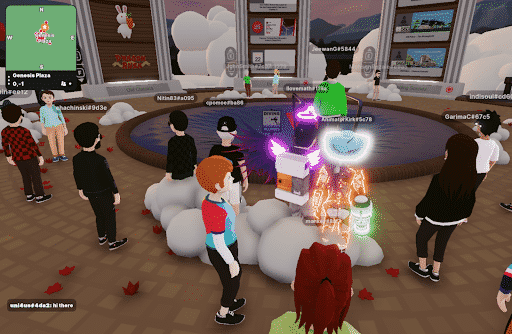
As background research for this series of blog posts, futures researcher Virpi Vaittinen, who belongs to Generation X, decided to visit Decentraland. This is how she describes her experiences:
“I’m not a gamer so navigating the metaverse seemed difficult. My laptop might be partly to blame but I could not control the movements of my avatar. People appeared next to me on the plaza and disappeared just as suddenly. I could have talked to them, but I didn’t know what I wanted to chat about with strangers.”
“I had made a light-hearted comment to a friend about setting up an exhibition in the metaverse. While visiting Decentraland, I realized we’d have to buy land and build a property before we could showcase works of art! There was a plot available next to Sotheby’s… but the cheapest plot I could find cost around 9,000 euros, an amount I had to convert from cryptocurrency.”
“Decentraland is just one of many metaverse platforms – I wonder what is happening elsewhere? I definitely have to check them out too – the metaverse is an exciting place to explore!”
